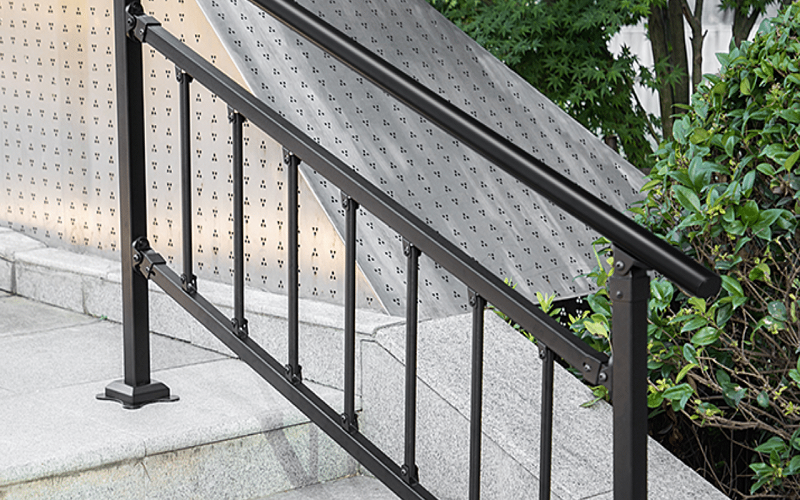Key Takeaways:
- Deck stair railing is important for safety and compliance with building codes.
- Railing prevents accidents and helps guide people up and down the stairs.
- Choosing the right materials, such as wood, metal, or composite, is crucial for safety.
- Stylish designs for deck stair railing include cable, glass, and ornamental balusters.
- Classic designs like wooden vertical balusters or wrought iron offer a timeless look.
- Personalize your railing with natural materials, DIY projects, or decorative accessories.
- Consider factors like aesthetics, budget, maintenance, and climate when choosing materials.
- Maintaining your railing involves regular cleaning, inspection, and addressing any damage.
- Functional features like built-in lighting, planters, and accessories can enhance your railing.
The Importance of Deck Stair Railing: Enhancing Safety and Compliance
1. Understanding the codes and regulations
When it comes to deck stair railing, safety should always be the top priority. Not only does proper railing add an extra element of security, but it also ensures that you are in compliance with local building codes and regulations. Understanding these codes is essential to avoid any potential issues and keep your deck safe for everyone to enjoy.
Building codes for deck stair railing typically specify the minimum height and spacing requirements, as well as the materials and construction methods that should be used. These codes are put in place to prevent accidents and injuries, particularly for decks that are raised above a certain height. The specific regulations may vary depending on your location, so it’s crucial to research and adhere to the guidelines in your area.
2. How deck stair railing prevents accidents
A deck stair railing acts as a protective barrier, preventing accidents and providing support for those using the stairs. Without proper railing, there is an increased risk of falls, especially for young children, the elderly, or individuals with mobility issues. The presence of a sturdy railing gives peace of mind and ensures that everyone can safely navigate the stairs.
In addition to preventing falls, deck stair railing also helps to guide people up and down the stairs, especially in low light conditions or during inclement weather. The railing serves as a visual aid, allowing individuals to easily identify the boundaries of the staircase and navigate with confidence.
iii. Choosing the right materials for maximum safety
When it comes to deck stair railing, the choice of materials plays a crucial role in ensuring maximum safety and durability. There are various options available, each with its own advantages and considerations.
One of the most popular materials for deck stair railing is wood. Wood railing provides a classic and timeless look, and it can be easily customized to match the aesthetics of your deck. However, it is important to choose a wood species that is known for its strength and resistance to decay, such as cedar or redwood. Regular maintenance, including staining or sealing, is also necessary to protect the wood from moisture and UV damage.
Another common material choice is metal, such as aluminum or wrought iron. Metal railing offers excellent strength and durability, making it a popular choice for those seeking a more modern and sleek look. It requires minimal maintenance and is resistant to rot and insects. However, metal can become hot to the touch in direct sunlight, so it’s important to consider the climate and location of your deck.
For a low-maintenance option, composite railing is worth considering. Made from a combination of wood fibers and recycled plastics, composite railing offers the look of wood without the maintenance requirements. It is resistant to rot and insects, and it does not splinter or crack. However, composite railing may have a higher upfront cost compared to other materials.
Elevating your Outdoor Space: Stylish Designs for Deck Stair Railing
1. Exploring modern and contemporary railing styles
If you’re looking to give your deck a modern and contemporary look, there are several stylish railing designs that can help you achieve this aesthetic. One popular option is cable railing, which consists of horizontal or vertical stainless steel cables attached to sturdy posts. This style creates a sleek and minimalist look, allowing for unobstructed views of your outdoor space. Cable railing is also durable and low-maintenance, making it a practical choice.
Another trendy option for modern deck stair railing is glass railing. Glass panels are secured in place with metal or wooden frames, creating a seamless and transparent barrier. This design is perfect for those who want to maximize the view from their deck and create an open and airy atmosphere. However, it’s important to note that glass railing may require more frequent cleaning to keep it looking its best.
If you prefer a more unique and artistic railing design, consider incorporating metal balusters with intricate patterns or shapes. These ornamental balusters can add visual interest and create a focal point for your deck staircase. From geometric patterns to nature-inspired motifs, there are endless possibilities to unleash your creativity and personalize your deck stair railing.
2. Classic and timeless designs for a traditional look
For those who prefer a more traditional and timeless look, there are several classic railing designs that never go out of style. One popular option is the wooden railing with vertical balusters, also known as pickets. This design exudes warmth and charm, and it can be customized with different baluster profiles and finishes to match your deck’s aesthetic.
If you want to add a touch of elegance to your deck stair railing, consider the beauty of wrought iron. Wrought iron railing is known for its intricate details and craftsmanship. It can be designed with various scrollwork patterns or simple geometric shapes, depending on your preference. While wrought iron railing requires periodic maintenance to prevent rust and corrosion, its timeless appeal makes it a favorite among homeowners.
For a classic yet durable option, consider aluminum railing. Aluminum railing offers the look of wrought iron but without the maintenance requirements. It is lightweight, resistant to rust and corrosion, and available in a variety of finishes. Aluminum railing can be easily customized to match the architectural style of your home, whether it’s traditional or contemporary.
iii. Unique and creative ideas to personalize your deck stair railing
Your deck stair railing can be a reflection of your personality and style. If you’re looking to add a unique touch, consider incorporating creative elements into your design. One idea is to use natural materials such as tree branches or driftwood as balusters. This rustic and organic look can bring a sense of nature to your deck and create a one-of-a-kind railing.
If you’re a fan of DIY projects, you can explore handrail designs that you can build yourself. From using repurposed materials like old doors or antique wrought iron gates to creating a mosaic pattern using tiles or pebbles, the possibilities are endless. Just remember to prioritize safety and ensure that your DIY railing is sturdy and meets the necessary building codes.
Another way to personalize your deck stair railing is by adding decorative accessories or accents. From post caps and finials to decorative brackets and lighting fixtures, these small details can make a big impact on the overall look of your railing. Consider incorporating elements that complement the style of your outdoor space and reflect your personal taste.
Materials and Maintenance: Finding the Perfect Balance
1. Comparing the pros and cons of different railing materials
When choosing the material for your deck stair railing, it’s important to consider the pros and cons of each option. This will help you find the perfect balance between aesthetics, durability, and maintenance requirements.
Wood railing offers a natural and warm look, but it requires regular maintenance to protect it from moisture and UV damage. Additionally, wood railing may be prone to rot and insect infestations if not properly maintained. However, it can be easily customized and repaired if damaged.
Metal railing, such as aluminum or wrought iron, is known for its strength and durability. It requires minimal maintenance and is resistant to rot and insects. However, metal railing may become hot to the touch in direct sunlight, and it may not offer the same level of customization as wood railing.
Composite railing offers the look of wood without the maintenance requirements. It is resistant to rot, insects, and warping, making it an excellent choice for those seeking a low-maintenance option. However, composite railing may have a higher upfront cost compared to other materials, and it may not offer the same level of warmth and natural beauty as wood.
2. How to choose the right material for your deck stair railing
When choosing the right material for your deck stair railing, consider factors such as your desired aesthetic, budget, maintenance preferences, and climate. Each material has its own unique characteristics that may make it more suitable for certain situations.
If you prioritize a natural and warm look, wood railing may be the best choice for you. Keep in mind that it will require regular maintenance and may not be as durable as metal or composite railing. However, with proper care, wood railing can last for many years.
If low maintenance is a priority, consider options like metal or composite railing. Both materials require minimal upkeep and offer excellent durability. Aluminum railing is lightweight and resistant to rust and corrosion, while composite railing is a blend of wood fibers and recycled plastics, providing a long-lasting and eco-friendly solution.
Lastly, climate should also be taken into consideration. If you live in an area with extreme temperature fluctuations or high humidity, it’s important to choose a material that can withstand these conditions. For example, metal railing may become uncomfortably hot in direct sunlight, while wood railing may be more prone to warping or rot in humid environments.
iii. Tips for easy cleaning and maintenance
To ensure the longevity and beauty of your deck stair railing, regular cleaning and maintenance are necessary. Here are some tips to make this task easier:
- Remove debris: Regularly sweep or brush away leaves, dirt, and other debris that may accumulate on your railing. This will prevent the buildup of moisture and potentially damaging substances.
- Clean with mild detergent: Use a mild detergent mixed with water to clean your railing. Scrub gently with a soft brush or sponge, paying attention to any stains or spots. Rinse thoroughly with clean water to remove any residue.
- Spot cleaning: For stubborn stains or mildew, you may need to use a specialized cleaner or bleach solution. Follow the manufacturer’s instructions and take precautions to protect surrounding surfaces, such as plants or furniture.
- Inspect for damage: Regularly inspect your railing for any signs of damage, such as loose screws, cracked wood, or rusted metal. Address these issues promptly to prevent further deterioration and ensure ongoing safety.
By incorporating these cleaning and maintenance practices into your routine, you can keep your deck stair railing looking its best and extend its lifespan.
Beyond Safety: Functional Features for Deck Stair Railing
1. Adding built-in lighting for enhanced visibility
Deck stair railing not only provides safety but can also enhance the functionality and aesthetics of your outdoor space. One way to achieve this is by incorporating built-in lighting into your railing design.
Installing lights along the railing not only improves visibility during nighttime or low-light conditions but also creates a warm and welcoming ambiance. There are various lighting options available, including LED strips or individual light fixtures that can be installed on or under the railing. Choose a lighting style that complements the overall design of your deck and consider adding dimming controls for added versatility.
2. Incorporating planters and flower boxes for a touch of nature
If you’re a fan of gardening or simply love the beauty of plants, consider incorporating planters or flower boxes into your deck stair railing. This creative idea not only adds a touch of nature to your outdoor space but also maximizes the use of space.
You can choose to install planters directly onto the railing or opt for hanging flower boxes that can be attached underneath. Select plants or flowers that thrive in your climate and complement the overall aesthetic of your deck. This not only adds visual interest but also enhances the ambiance and creates a more inviting atmosphere.
iii. Installing accessories to maximize usability and convenience
To truly make your deck stair railing functional and convenient, consider adding accessories that maximize usability. There are various options available to suit your specific needs and preferences.
If you enjoy hosting outdoor gatherings or relaxing with a cold beverage, consider installing a built-in drink rail. This feature provides a flat surface along the railing for placing drinks or snacks, eliminating the need for additional tables or surfaces.
Another useful accessory is a handrail grip, particularly for those with grip or mobility issues. This additional grip can provide extra support when going up or down the stairs, making it easier and safer for everyone to navigate the deck.
For pet owners, incorporating a pet gate into your deck stair railing can be a game-changer. This feature allows you to control access to your deck and prevents pets from going up or down the stairs unsupervised. Choose a gate with a secure latch and consider the height and spacing requirements to ensure the safety of your furry friends.
With this complete guide to deck stair railing, you now have a comprehensive understanding of its importance, the different design options available, the best materials to choose from, and how to properly maintain and enhance its functionality. By considering safety, style, and functionality in your deck stair railing, you can create a space that not only looks visually appealing but also provides a safe and enjoyable outdoor experience for all. So, go ahead and start planning your deck renovation or upgrade, and make the most of your outdoor living space!
FAQ
Question: What are the building codes and regulations for deck stair railing? Answer: Building codes typically specify minimum height and spacing requirements, as well as materials and construction methods. These codes vary by location and are in place to prevent accidents and injuries.
Question: How does deck stair railing prevent accidents? Answer: Deck stair railing acts as a protective barrier, preventing falls and providing support. It also helps guide people up and down the stairs in low light or bad weather conditions.
Question: What are the different options for deck stair railing materials? Answer: Wood, metal, and composite are popular materials. Wood offers a classic look but requires maintenance. Metal provides strength and durability, while composite is low-maintenance.
Question: What stylish designs are available for deck stair railing? Answer: Cable railing creates a sleek and minimalist look, glass railing offers transparency, and ornamental balusters add artistic interest. Classic designs include wooden vertical balusters and wrought iron.
Question: How can I personalize my deck stair railing? Answer: You can use natural materials, such as tree branches or driftwood, for a rustic look. DIY projects are also an option, like using repurposed materials, or adding decorative accessories and accents.
Question: How do I choose the right material for my deck stair railing? Answer: Consider aesthetics, budget, maintenance preferences, and climate. Wood provides a warm look, metal and composite require less maintenance, and climate affects material durability.
Question: What are some tips for cleaning and maintaining deck stair railing? Answer: Regularly remove debris, clean with mild detergent, spot clean stubborn stains, and inspect for damage. Following these practices will keep your railing looking its best and ensure its longevity.
Question: What functional features can I add to my deck stair railing? Answer: Built-in lighting improves visibility, planters and flower boxes bring nature to your railing, and accessories like drink rails and pet gates enhance usability and convenience.




